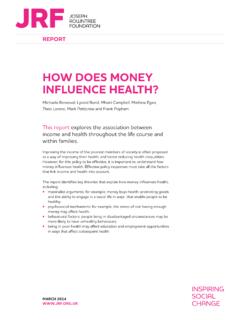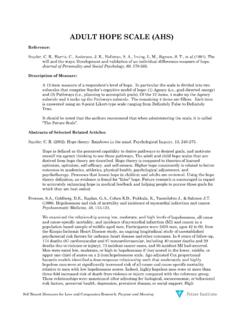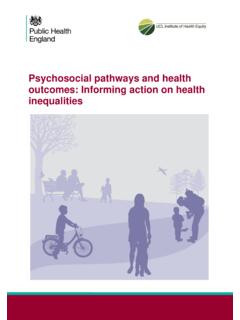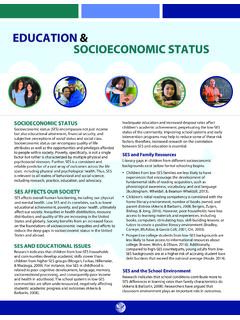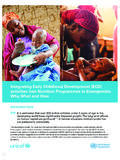Transcription of Technical Note: Protection of Children during the ...
1 1 Technica l Note: Protection of Children during the C oronavirus Pandemic ( )1 Photo courtesy of UNICEF/Leonardo Fernandez/India 2019 Introduction Infectious diseases like COVID-19 can disrupt the environments in which Children grow and develop. Disruptions to families, friendships, daily routines and the wider community can have negative consequences for Children s well -being, development and Protection . In addition, measures used to prevent and control the spread of COVID-19 can expose Children to Protection risks. Home-based, facility-based and zonal-based quarantine and isolation measures can all negatively impact Children and their 1 Suggested Citation: The Alliance for Child Protection in Humanitarian Action, Technical Note: Protection of Children during the Coronavirus Pandemic, Version 1, March 2019 2 For more information on quarantines, consult pages 14 15 of the Guidance Note: Protection of Children during Infectious Disease Outbreaks 2 The aim of this brief is to support child Protection practitioners to better respond to the child Protection risks during a COVID-19 pandemic.
2 Part 1 presents the potential child Protection risks COVID-19 can pose to Children . Part 2 presents programmatic options in line with the 2019 Minimum Standards for Child Protection in Humanitarian Action (CPMS) and the Guidance Note: Protection of Children during Infectious Disease Outbreaks. 1. Child Protection in the context of the coronavirus COVID-19 can quickly change the context in which Children live. Quarantine measures such as school closures and restrictions on movements disrupt Children 's routine and social support while also placing new stressors on parents and caregivers who may have to find new childcare options or forgo work. Stigma and discrimination related to COVID-19 may make Children more vulnerable to violence and psychosocial distress.
3 Disease control measures that do not consider the gender-specific needs and vulnerabilities of women and girls may also increase their Protection risks and lead to negative coping mechanisms. Children and families who are already vulnerable due to socio-economic exclusion or those who live in overcrowded settings are particularly at risk. Socio-ecological impact of COVID-19 1 Child Protection risks Some of the child Protection risks below are observed in the current COVID-19 pandemic and some are potential risks observed in previous infectious disease outbreaks. Risks presented by COVID-19 and related control measures Causes of risks Child Protection Risk: Physical and emotional maltreatment Reduced supervision and neglect of Children Increase in child abuse and domestic/interpersonal violence Poisoning and other danger and risks of injuries to Children Pressure on or lack of access to child Protection services Childcare/school closures, continued work requirements for caregivers, illness, quarantine/isolation of caregivers Increased psychosocial distress among caregivers and community members Availability and misuse of toxic disinfectants and alcohol Increased obstacles to reporting incidents Child Protection Risk.
4 Gender-based violence (GBV) Increased risk of sexual exploitation of Children , including sex for assistance, commercial sexual exploitation of Children and forced early marriage Pressure on or lack of access to child Protection /GBV services Reduced family Protection of Children Reduced household income and/or reliance on outsiders to transport goods and services to the community Girls gender-imposed household responsibilities such as caring for family members or doing chores Increased obstacles to reporting incidents and seeking medical treatment or other supports Child Protection Risk: Mental health and psychosocial distress Distress of Children due to the death, illness, or separation of a loved one or fear of disease Worsening of pre-existing mental health conditions Pressure on or lack of access to MHPSS services Increased stress levels due to isolation in treatment units or home-based quarantine Children and parents/caregivers with pre-existing mental health conditions may not be able to access usual supports or treatments Quarantine measures can create fear and panic in the community, especially in Children , if they do not understand what is happening 2 Risks presented by COVID-19 and related control measures Causes of risks Child Protection Risk.
5 Child labour Increased engagement of Children in hazardous or exploitative labour Loss or reduction in household income Opportunity or expectation to work due to school closure Child Protection Risk: Unaccompanied and separated Children Separation Becoming unaccompanied or child head of household Being placed in institutions Loss of parents/caregivers due to disease Isolation/quarantine of caregiver(s) apart from child(ren) Children sent away by parents to stay with other family in non-affected areas Child Protection Risk: Social exclusion Social stigmatisation of infected individuals or individuals/groups suspected to be infected Increased risk/limited support for Children living/working on the street and other Children already at risk Increased risk/limited support to Children in conflict with the law, including those in detention Social and racial discrimination of individuals/groups suspected to be infected Disproportionate impact on more disadvantaged and marginalized groups Closure/inaccessibility of basic services for vulnerable Children and/or families Disruption to birth registration processes due to quarantine 2.
6 Child Protection Response Advocacy with government, collaboration with other sectors, and child Protection -specific programming are key priorities during a COVID-19 response. Working across sectors and with governments As highlighted in the CPMS, the prevention of and response to infectious disease outbreaks requires close coordination and collaboration between several sectors. A multi-sectoral response (a) ensures that Children and caregivers needs are addressed holistically and (b) leads to better outcomes for Children . Child Protection actors should also consider collaborating with religious and traditional leaders. Multi-sectoral interventions should prioritise: Standard procedures for documenting and referring Children 's cases that may need follow-up; 3 Clear protocols to prevent/reduce family separation and other forms of child Protection risks; Reduce stigma and social exclusion that may result from the disease; and Clear, coordinated, child-friendly community messaging on Children 's unique risks and vulnerabilities related to the outbreak.
7 In working with government, CP actors should advocate to ensure measures implemented to address COVID-19 accord with international standards, in line with the WHO advisory, and are human rights-based, non-discriminatory and proportionate. The following are priority actions for working across sectors and with governments towards a child Protection -sensitive response. health (CPMS Standard 24) Advocate for vulnerable Children and their families free access to healthcare (if it is not universal). Collaborate to include CP concerns in health sector assessment and monitoring tools. Develop common standard procedures for documenting and referring Children s cases between CP and health services to ensure Children receive safe, appropriate, family-based care if separated.
8 Advocate for clear and child-friendly intake and discharge procedures to promote family unity and reduce the risk of separation. Facilitate safe and regular communication between Children and parents/caregivers who are temporarily separated. Collaborate to ensure child-friendly health facilities/access to health care, including guidance for health staff on child-friendly communication and special measures to support Children s psychosocial well-being when undergoing treatment and quarantine. Support child safeguarding training for health workers (particularly where Children are separated from their families or caregivers). Establish safe, child-friendly complaints and feedback mechanisms in health care facilities.
9 Strengthen capacity on clinical management of rape (CMR) and ensure minimum CMR supplies are available in key facilities to appropriately respond to sexual violence. Collaborate on mental health and psychosocial support (MHPSS) care and messaging for Children and caregivers affected by COVID-19. Include measures to protect Children during a COVID-19 outbreak in contingency plans. Ensure that information, education and communication (IEC) materials, including information on available services, are produced and displayed with limited text in child-friendly versions. WASH (CPMS Standard 26) Collaborate to ensure child-friendly hand-washing stations are available at health facilities, schools, child care centres, alternative care centres, and other locations Children are likely to visit.
10 Collaborate to provide safe, child-friendly hygiene promotion activities before and during outbreaks, including the development of posters and infographics targeting Children , parents/caregivers and teachers. Collaborate on safety audits to assess and address any safety needs at WASH facilities. 4 Nutrition (CPMS Standard 25) Ensure Children and families in quarantine, self-isolation or health facilities have access to adequatenutritional support. Collaborate on safety audits to assess and address any safety needs at nutrition (CPMS Standard 23; INEE List of Resources) Limit the impact of school interruption by using child-friendly distant education methods such as TV,radio or online learning. Advocate with government and private employers for flexible working arrangement for parents andcaregivers who may have lost access to childcare to enable them to continue care and education oftheir Children .










